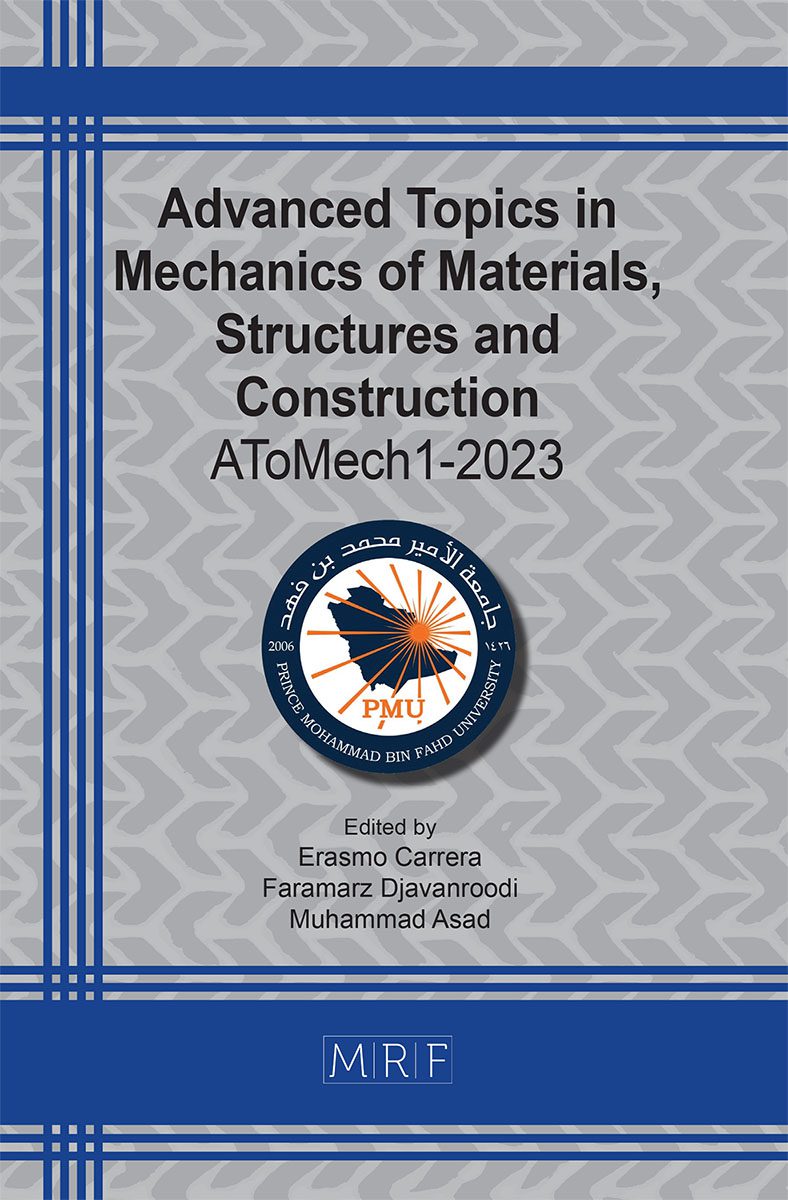A homogenized finite element analysis of the deformation of axially-loaded thin-walled epoxy/coir fibre-reinforced aluminum 6063 composite tubes
B.O. Malomo
download PDFAbstract. Metal-fibre hybridization is strategic to the development of efficient lightweight energy absorbing structures. In this study, the deformation of variable coir-fibre reinforcement volumes (10%-90%) hybridized at reinforcement thicknesses (10T, 15T and 20T) with aluminum alloy 6063 tubes was investigated from a continuum standpoint to unravel the underlying mechanisms of the composite’s performance potential. A representative volume element (RVE) was developed to determine the effective properties of coir-fibers based on Mori-Tanaka/Benveniste theoretical model in DIGIMAT 2017.0, while the aluminum alloy properties were defined by Johnson-Cook’s plasticity. Finite element (FE) simulations were implemented in ABAQUS Explicit Dynamics by deformable continuum elements to capture the damage initiation and evolution response based on the Hashin’s stiffness degradation failure criteria and the strength-based cohesive zone, traction-separation law. Incidental high peaks and unstable buckling loads at the onset of crushing was significant for 10T and 15T tubes with 10-30% and 80-90% reinforcement concentrations (Vf) relative to the low frequency of fluctuations at 40-70%, Vf. Axisymmetric to non-asymmetric transformations occurred with relative significance for the tubes as the resistance to global bending increased with reinforcement thickness. The interaction between the tube walls and reinforcement layers in preventing the formation of complete folds notably increased with 15T and 20T tubes at 60% fiber concentration, where the extensional collapse by progressive delamination of the 20T tubes improved the buckling resistance at densification. In agreement with FE simulations, experimental stress-strain plots at 60% Vf, confirmed that 20T tubes indicated wider plateau region of stable crushing to underscore observed high capacities for energy absorption.
Keywords
Tube Thickness, Coir-Fibre, Deformation, Aluminum 6063, Energy Absorption
Published online 8/10/2023, 10 pages
Copyright © 2023 by the author(s)
Published under license by Materials Research Forum LLC., Millersville PA, USA
Citation: B.O. Malomo, A homogenized finite element analysis of the deformation of axially-loaded thin-walled epoxy/coir fibre-reinforced aluminum 6063 composite tubes, Materials Research Proceedings, Vol. 31, pp 485-494, 2023
DOI: https://doi.org/10.21741/9781644902592-50
The article was published as article 50 of the book Advanced Topics in Mechanics of Materials, Structures and Construction
![]() Content from this work may be used under the terms of the Creative Commons Attribution 3.0 license. Any further distribution of this work must maintain attribution to the author(s) and the title of the work, journal citation and DOI.
Content from this work may be used under the terms of the Creative Commons Attribution 3.0 license. Any further distribution of this work must maintain attribution to the author(s) and the title of the work, journal citation and DOI.
References
[1] Weirzbicki, T and Abramowicz, W (1983). On the crushing mechanism of thin-walled structures. Journal of applied mechanics, 50 (4), 727-734. https://doi.org/10.1115/1.3167137
[2] Wang, Z., Jin, X., Li, Q and Sun, G (2020). On crashworthiness design of hybrid metal- composite structures, Int. J. of Mechanical Sciences, 171, 105380, Elsevier Science Ltd. https://doi.org/10.1016/j.ijmecsci.2019.105380
[3] Cui, Z., Liu, Q., Sun,Y and Li, Q (2020). On crushing responses of filament winding CFRP/aluminum and GFRP/CFRP/aluminum hybrid structures, Composites Part B: Engineering, 200, 108341, Elsevier Science Ltd. https://doi.org/10.1016/j.compositesb.2020.108341
[4] Paz, J., Diaz, J., Romera, L and Costas, M (2014). Crushing analysis and multi-objective crashworthiness optimization of GFRP honeycomb-filled energy absorption devices, Finite Elements in Analysis and Design 91, 30-39, Elsevier Science Ltd. https://doi.org/10.1016/j.finel.2014.07.006
[5] Jung, D., Kim, H and Choi, N (2009). Aluminum-GFRP hybrid square tube beam reinforced by a thin composite skin layer, Composites Part A: Applied Science and Manufacturing, 40 (10), 1558-1565, Elsevier Science Ltd. https://doi.org/10.1016/j.compositesa.2009.06.015
[6] Farley, G (2016). Effect of specimen geometry on the energy absorption capability of composite materials, Journal of Composite Materials, 20 (4), Sage Journals. https://doi.org/10.1177/002199838602000406
[7] Islam, M; Hasbullah, N; Hasan, M; Tahb, Z; Jawaid, M and Haafiz, M (2015). Physical, mechanical and bio-degradable properties of kenaf/coin hybrid fiber reinforced polymer nanocomposites. Materials Today Communication, 4, 69-76. https://doi.org/10.1016/j.mtcomm.2015.05.001
[8] Jawaid, M; Thariq, M and Saba, N (2019). Mechanical and physical testing of bio-composites, fiber-reinforced composite and hybrid composites wood herd publishing, Elsevier, 43-57.
[9] Benveniste, Y (1987). A new approach to the application of Mori-Tanaka’s theory in composite materials. Mechanics of materials 6 (2): 147-157. Elsevier Science Ltd. https://doi.org/10.1016/0167-6636(87)90005-6































